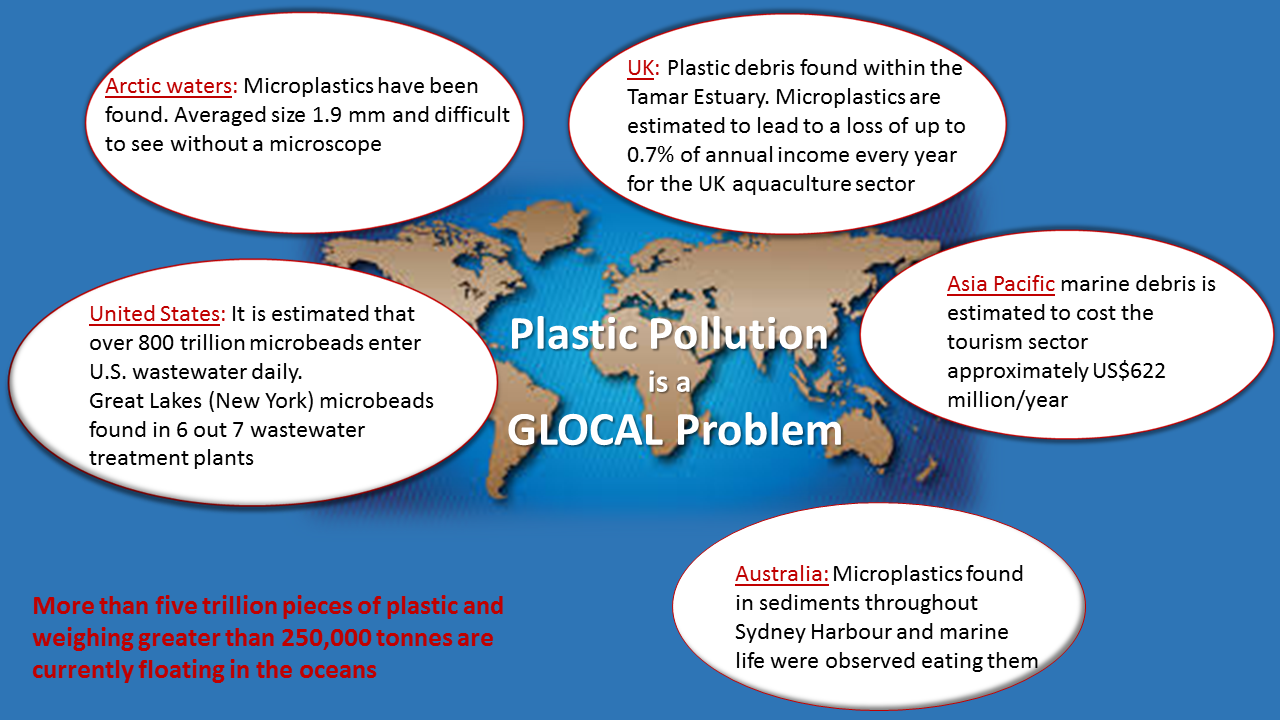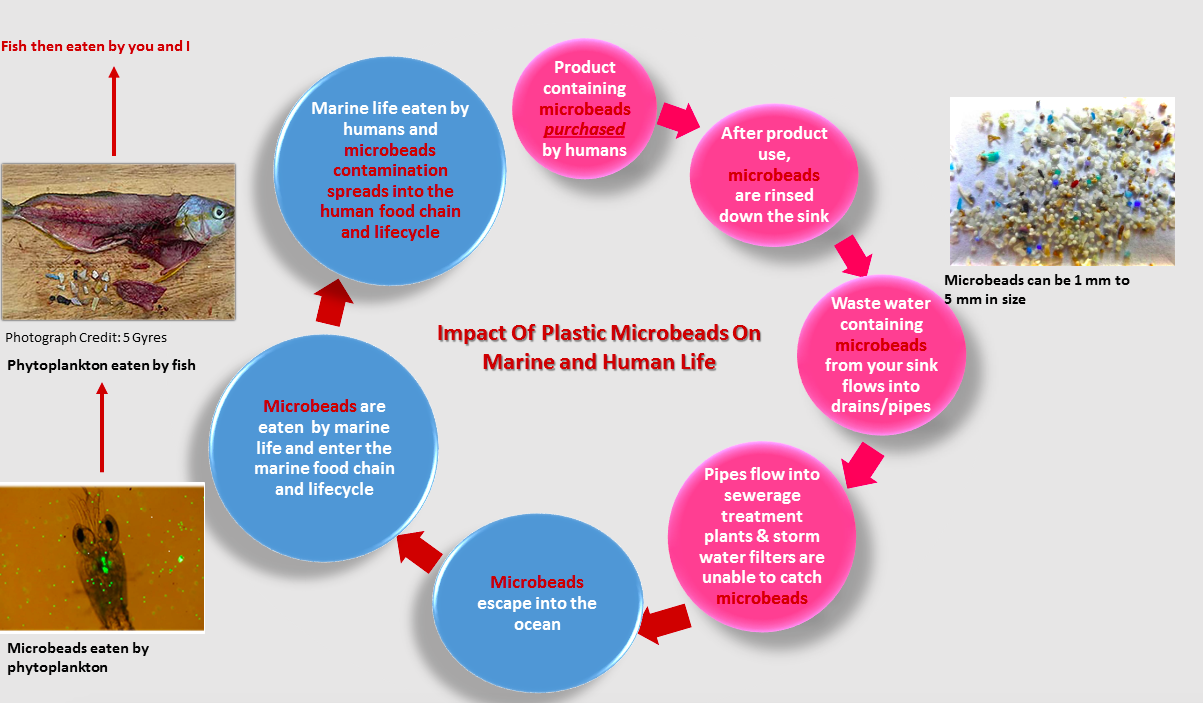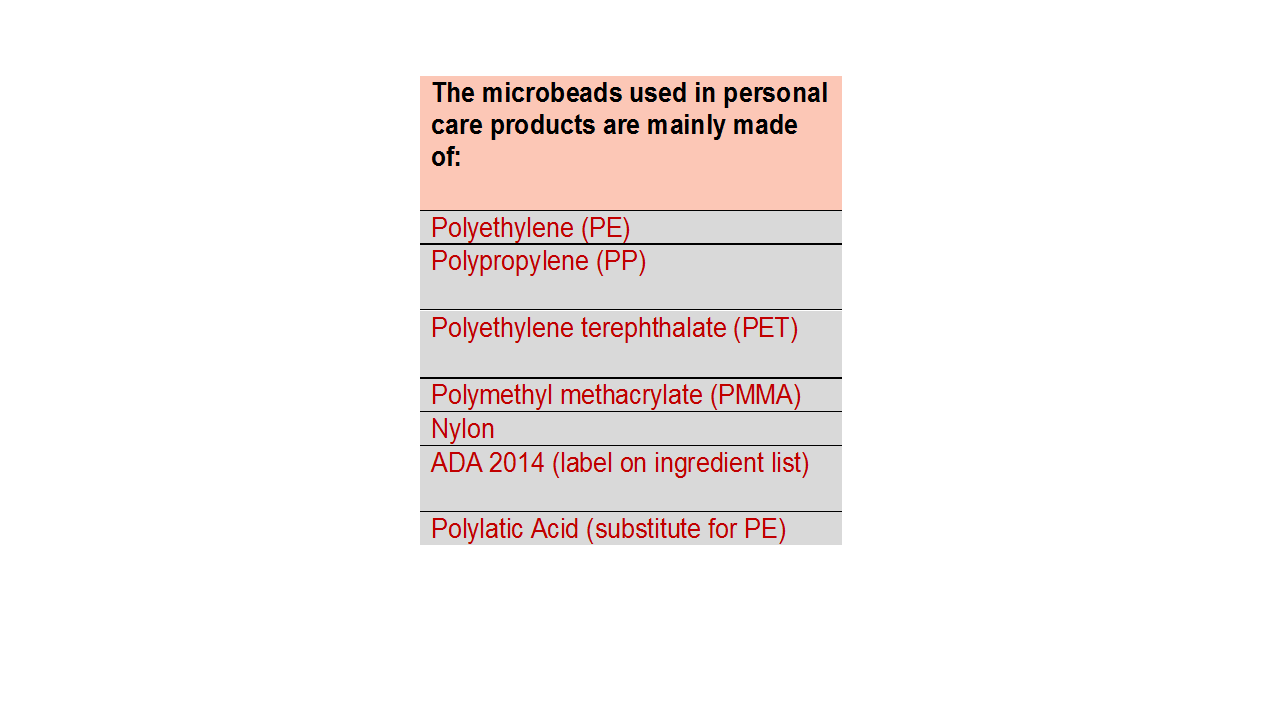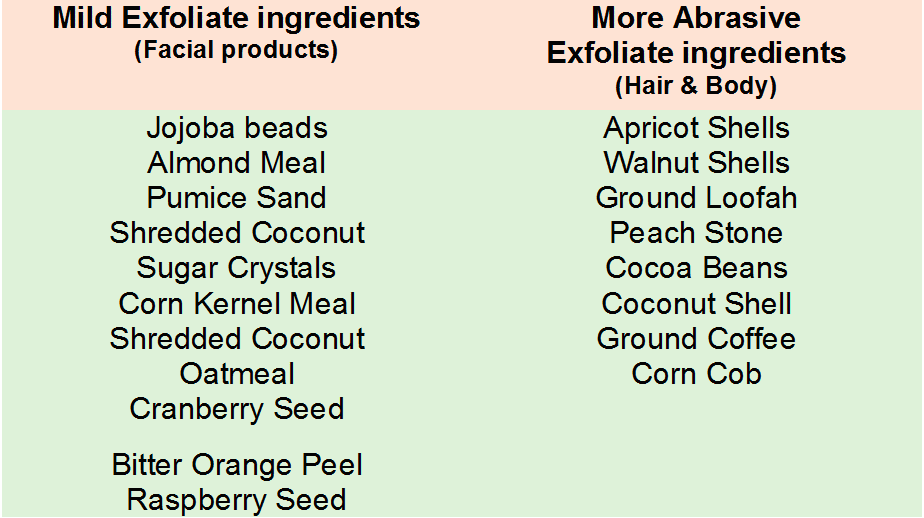Can you cut 1 Tonne of carbon pollution out of your life?
Take the challengeThe following investigation is a guest blog from cosmetic chemist Daphne Kapetas.
The answer should be nothing!
What do facial scrubs and fish have in common?
Again, the answer should be nothing!
What about toothpaste? Does toothpaste have anything in common with the fish we eat?
Idyllic beaches, fish, facial scrubs, body wash, toothpaste and maybe even some of the food we choose to eat, unfortunately, all have something in common, microplastics. More specifically plastic microbeads.
What are microplastics?
Microplastics are made from plastic, the same plastic that is used to make plastic bottles. They are tiny pieces of plastic fibres measuring less than 5mm. The microbeads found in personal care products are smaller than 1mm. These microbeads are used in some personal care products like facial scrubs, body peels, shampoos and they can also be used to add colour into toothpaste.
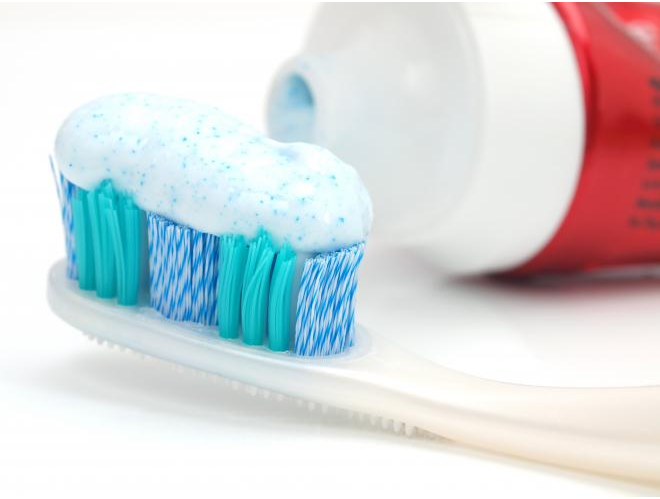
Image: Shutterstock
Marine litter has economic, social and ecological impacts from the local to the global level. (GLOCAL)
The plastic waste that you see by the beach and in the sea, are the bleeding obvious cases of plastic pollution. Plastic pollution ends up causing havoc on our marine life, due to death by plastic. Autopsies that are being conducted on dead whales and birds are finding huge amounts of plastic in their guts. This is something that we do sometimes get to read in mainstream media. (1)
But what about the plastic pollution in the deep sea floor and throughout our water column?
Our love affair with plastic began in 1907, but it wasn't until World War II that there was a drastic increase in its production. (2) Plastic debris in our oceans was first observed in the 1960s and given that this is relatively recent, we are not 100% sure as to how long plastic persists in the environment. However, scientists predict that it may take hundreds if not thousands of years before it can degrade. (3)
We wake up in the morning, wash our face and body with products and then brush our teeth with more products and the majority of us happily assume that manufacturers are doing the right thing when making these products.
Well, most of the time they do and sometimes they don't…
Over the years, microbeads have replaced the more expensive naturally derived and biodegradable ingredients that were once used in personal care products, as they are cheaper exfoliators or abrasives. One tube of facial scrub can contain more than 300,000 plastic microbeads. Some dentists and hygienists in the USA, are noticing coloured specks of beads on people's teeth. (4)
Can this really be good for you?
As we wash with products containing microbeads, these tiny toxins begin their journey of destruction by flowing down our pipes and into our sewage system. Big pieces of plastic are removed by sewage treatment plants and stormwater filters, but these microbeads surreptitiously escape into our rivers, lagoons and oceans.
Some Key Facts: Around The World
- ´The most globally abundant contaminants are plastics of which more than 280 million tonnes are produced each year. (5)
- ´Microplastic pollution has spread throughout the world's oceans through the water column[i]. (6)
Image: Daphne K Knows
References used: (7) (5) (8) (9) (10)
Some Key Facts: The relationships between living things and our environment (Ecology[i])
- ´Plankton are small drifting organisms found in aquatic environments. A study of archived plankton from the northeast Atlantic showed that the abundance of microscopic plastics in the water column has increased considerably over the last 40years. (11)
So why the fuss over PLANKTON?
More specifically, phytoplankton (micro algae) which are:
- Microscopic plant-like organisms, tiny sea-like creatures.
- Bottom and base of the marine food chain.
- They absorb carbon dioxide and produce oxygen. (Oxygen the stuff WE need!)
Because phytoplankton are so critical to ocean biology and climate, any change in their productivity could have a significant impact on biodiversity, fisheries, our food supply, and the rate of climate change. (11)
Microbeads are accidently eaten by phytoplankton, then the bigger fish come along and eat them.
You guessed it, then we come along and eat the fish that ate the phytoplankton, that ate the microbeads!
References: http://www.beatthemicrobead.org/en/
Image: Daphne K Knows
To make matters worse, microplastics are like sponges that soak up toxic chemicals, like DDT or PCBs. Microplastics that are then eaten by the marine life transfer contaminants into the marine food web and as animals eat each other, these contaminants move up the food chain.
Interestingly, the word ecology, is derived from the Greek word οἶκος, "house"; -λογία, "study of". Would you dump rubbish in your own back yard?
Begin with the end in mind:
What can I do, I hear you say? Think about what you would like to achieve (such as no microplastics in the ocean) and make decisions based on that goal.
Each and every one of us, can make a difference by the choices we make. Here's how…
1) Read product labels
The following is a list of ingredients that appear on the back of product packaging. These are the toxins to beware of when purchasing personal care products.
Image: Daphne K Knows
2) Check out Beat The Microbead
Download the app found here to decide whether to buy a product or not.
3) Check out Good Scrub Guide . Tangaroa Blue Foundation's, Australian Marine Debris Initiative has a sensational guide which assesses the use of plastic abrasives in facial exfoliators. There is both an Australian and UK Edition called the "Good Scrub Guide".
4) Look for personal care products that contain biodegradable and naturally sourced exfoliants or abrasives.
They can include:
Image: Daphne K Knows
What Now?
Renowned Scientist, Dr Jiann Yu a Research Professor from the Hawaii Natural Energy Institute, School of Ocean and Earth Science & Technology at the University of Hawaii at Manoa, is working tirelessly to invent true biodegradable plastic. Dr Yu is developing a bioplastic made by microbes that can degrade in cold seawater. It is also as an energy and carbon reserve.
So until alternatives like this bioplastic are ready, minimise your relationship with plastic.
Next Steps:
Dr Yu advises me that a United Nations agency is calling for personal product and cosmetic makers to globally phase out plastic microbeads. It also warns against the use of beads made of "biodegradable" plastics such as polylatic acid (used as a substitute for the widely used plastics such as polyethylene) because polylatic acid only degrades at high temperatures in industrial settings.
Be careful, some companies claim that their plastic microbeads are biodegradable… don't go there!
Some companies have agreed to slowly phase out the use of microbeads from their products and they have until 2020 to get it right.
President Obama has recently signed a new law that will ban the selling of environmentally-damaging microbeads in soaps and toothpaste by July of 2017. The call to action for Australia to follow the US is slowly gaining momentum.
Until then…
We are always told not to take things for granted and then we nod our heads in unison; "Yes..Yes". But do we actually ever sit still long enough to imagine what life would be like without life in our seas and without life in our skies?
Our understanding of the potential contamination from microplastics entering our environment, relatively speaking, is in its early days and some questions are yet unanswered (12). Our marine life, on the other hand, is obviously having a hard time from our plastic pollution, amongst the many other challenges they face.
It is clear that microplastics are an emerging threat that requires our attention.
I live by "The Precautionary Principle".
Prove that microbeads are SAFE before you expose living creatures to them.
Until then, read product labels. If the product contains plastic microbeads -
Just don't buy it.
Walk the talk, It's as easy as that!
You have the power, choose well.
The nose knows.
Daphne K Knows.
Daphne Kapetas is a qualified and experienced cosmetic chemist and marketer with a passion for sustainability and the dance floor. Having worked in the beauty industry with multinationals from, 'concept, product development to product launch,' for 15 years, she is an authority on all things cosmetic. Keep up with her:
Blog Daphne K Knows
Header image: Shutterstock
Read this next: 10 Simple things you can do to lower your energy consumption at work
Try this next: DIY your own laundry detergent
1 Million Women is more than our name, it's our goal! We're building a movement of strong, inspirational women acting on climate change by leading low-carbon lives. To make sure that our message has an impact, we need more women adding their voice. We need to be louder. Joining us online means your voice and actions can be counted. We need you.
Special Thanks:
| Ray Townsend Cosmetic Scientist | Cosmetic Technical Services Pty Ltd |
| Dr Jian Yu Research Professor | Hawaii Natural Energy Institute |
| School of Ocean and Earth Science and Technology | |
| The University of Hawaii and Manoa |
References:
1. Blair, Olivia. Huge mass of rubbish, including plastic bags and fishing nets, found in dead whale's stomach in Taiwan. Independent UK. [Online] 28 October 2015. [Cited: 29 October 2015.] http://www.independent.co.uk/environment/huge-mass....
2. The History And Future Of Plastics. Conflicts In Chemistry. [Online] [Cited: 15 October 2015.] http://www.chemheritage.org/discover/online-resour....
3. Plastic in your face wash could be harming Great Lakes. TheRecord.Com. [Online] 6 April 2015. [Cited: 15 October 2015.] http://www.therecord.com/news-story/5542971-plasti....
4. Which Toothpastes Contain Microbeads? Social Dental Network. [Online] 23 September 2014. [Cited: 16 October 2015.] http://dentalpatientnews.com/which-toothpastes-con....
5. Microplastic Threat To Sydney Harbour. UNSW Science. [Online] 24 August 2014. [Cited: 13 October 2015.] http://www.bees.unsw.edu.au/microplastic-threat-sy....
6. François Galgani, Georg Hanke,Thomas Maes. Springer LInk. Marine Anthropogenic Litter. Global Distribution, Composition and Abundance of Marine Litter. [Online] 2 June 2015. [Cited: 2015 October 2015.] http://link.springer.com/chapter/10.1007/978-3-319....
7. Plastic pollution in the world's oceans: More than 5 Trillion plastic pieces weighing over 250,000 tons afloat at sea. Eriksen, M., Lebreton, L. C. M., Carson, H. S., Thiel, M., Moore, C. J., Borerro, J. C., et al. 9, s.l. : PLoS ONE, 2014. e111913.
8. Yereth Rosen. Microplastics found in waters off Svalbard, raising more concerns about Arctic Ocean pollution. Artic News Wire. [Online] 14 October 2015. [Cited: 16 October 2015.] http://www.adn.com/article/20151013/microplastics-....
9. Lusher, A. L. et al. . Microplastics in Arctic polar waters: the first reported values of particles in surface and sub-surface samples. nature.com. [Online] 8 October 2015. [Cited: 16 October 2015.] http://www.nature.com/articles/srep14947. Sci. Rep. 5, 14947; doi: 10.1038/srep14947 (2015)..
10. Emma Watkins,Patrick ten Brink,Sirini Withana,Konar Mutafoglu,Jean-Pierre Schweitzer,Daniela Russi,Marianne Kettunen. Marine litter: socio-economic study. [Online] 2 June 2015. [Cited: 21 October 2015.] https://www.bundesregierung.de/Content/DE/_Anlagen....
11. Rebecca Lindsey and Michon Scott. What are Phytoplankton? Earth Observatory. [Online] 13 July 2010. [Cited: 15 October 2015.] http://earthobservatory.nasa.gov/Features/Phytopla....
12. Molland, Judy. California Says 'No' To Plastic Micobeads. Care2. [Online] 13 Ocrober 2015. [Cited: 14 October 2015.] http://www.care2.com/causes/california-says-no-to-....
13. Microplastic - An Emerging Contaminant Of Potential Concern. Mark Anthony Browne,Tamara Susan Galloway. s.l. : INTEGRATED ENVIRONMENTAL ASSESSMENT AND MANAGEMENT , 2007, Vol. November.
14. Greenwall, Linda. Plastic... not always fantastic. Aesthetic Dentistry Today. August, 2015.
15. Plastic debris in the open ocean. Cózar, A., Echevarría, F., González-Gordillo, J. I., Irigoien, X., Úbeda, B., Hernández-León,S., et al. 111, s.l. : Proceedings of the National Academy of Sciences of the United States of America, 2014, Vol. 28. 10239–10244..
16. Galloway, Tamara S. Micro- and Nano-plastics. Springer Link. [Online] 2 June 2015. [Cited: 25 October 2015.] http://download.springer.com/static/pdf/610/chp%25...=1445907686~acl=%2Fstatic%2Fpdf%2F610%2Fchp%25253A10.1007%25252F978-3-31.
17. Water Column. EcologyDictionary.Org. [Online] US Environmental Protection Agency, 2008. [Cited: 29 October 2015.] http://www.ecologydictionary.org/water_column.

